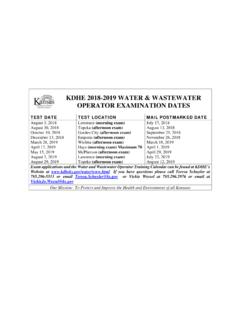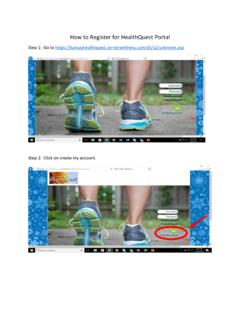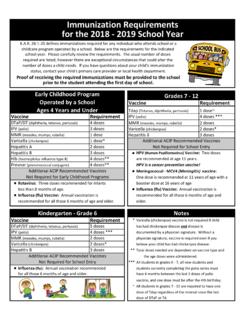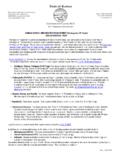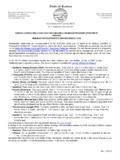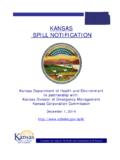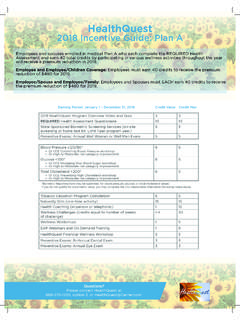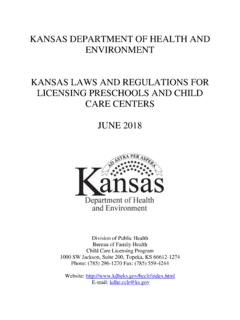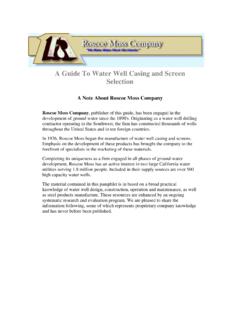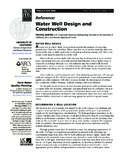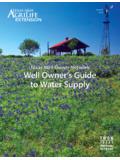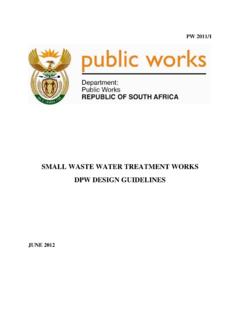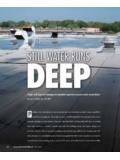Transcription of MF2214 Minimum Standards for Design and Construction …
1 AaaaaaaaaaaaState of KansasDepartment of Healthand EnvironmentBulletin 4-2, March 1997 Minimum STANDARDSFOR Design ANDCONSTRUCTION OF ONSITEWASTEWATER SYSTEMSB ureau of Water Nonpoint Source SectionForbes Field, Bldg. 283 Topeka KS 66620(785) 296-4195In Cooperation withK-State Research and ExtensionTable of ContentsIntroduction .. 1 Wastewater Flows .. 2 Site and Soil Evaluation .. 2 Septic Tank .. 6 Septic Tank Design / Construction Specifications .. 7 Septic Tank Placement Specifications .. 9 Absorption Field Size.
2 10 Absorption Field Material Specifications .. 12 Field Construction Specifications .. 13 Maintaining Onsite Wastewater Systems .. 13 Waste Stabilization Ponds .. 13 Alternative Systems Guidelines .. 14 Appendix A Conducting a Perc Test .. 14 Appendix B Sources of Additional Information .. 16 KDHE District Boundaries andDistrict Offices .. Inside back coverTables1 Soil Limitation Ratings Used by NRCSfor Wastewater Absorption Fields .. 22 Design Septic Tank Effluent Loading Rates forVarious Soil Textures and Structures.
3 33 Recommended Absorption Reductions .. 44 Soil Absorption Field Loading Rateand Area Recommendation for Septic TankEffluent Based on Perc .. 45 Minimum Required and MinimumRecommended Separation Distancesfor Onsite Wastewater Systems .. 46 General Alternative Option Guidefor Moderate or Severe LimitingSoil Conditions .. 57 Minimum and Recommended SepticTank Capacities Based on theNumber of Household Bedrooms .. 68 Trench Separation Distances .. 11 Figures1 Compartmentalized Septic Tank.
4 62 Design Details for a Precast,Concrete Septic Tank .. 73 Septic System Reference Sketch .. 84 Typical Step Down or SerialDistribution System .. 105 Standard Lateral Trench Design .. 111 IntroductionKansas Administrative Regulations ( 28-5-6 to9) authorize the Kansas Department of Health and Envi-ronment (KDHE) to establish Minimum Standards forseptic tank lateral fields. KDHE bulletin 4-2: MinimumStandards for Design and Construction of Onsite Wastewa-ter Systems fulfills that purpose. The Minimum standardspresented in this document are intended to ensure do-mestic wastewater is managed so that.
5 NQuality of surface and groundwater is protected fordrinking water, recreation, aquatic life support, irri-gation, and industrial breeding place or habitat will not be created forinsects, rodents, and other vectors that may latercontact food, people, pets, or drinking will not be exposed on the ground sur-face where it can be contacted by children and/orpets, creating a significant health and federal laws and local regulations governingwater pollution or wastewater disposal will be conditions or obnoxious odors and un-sightliness will be 4-2 is not intended to provide an in-depthdiscussion of the rationale for these Standards .
6 For moreinformation, see the Environmental Health Handbook andresources identified therein as well as other references inAppendix B (page 16). Most county health departmentshave a copy of this handbook, or copies are available atcost from Kansas State University, Extension Biologicaland Agricultural Engineering (see Appendix B).Local governments have the authority to adopt mini-mum requirements (codes) for onsite wastewater man-agement systems, to approve individual plans, to issuepermits for Construction , to issue permits for operation,and to grant variances.
7 County sanitary (environmental)codes specif y local Design and permitting with these requirements helps preventillness caused by environmental contamination andprotects surface and local requirements, such as those inwellhead protection or sensitive groundwaterareas, may be more stringent than those estab-lished in Bulletin 4-2. Often, these stricter re-quirements provide greater protection of publichealth and the environment, especially wherewater resources are vulnerable to codes are adopted and administered bylocal government usually through county health depart-ments.
8 The local administering authority should alwaysbe contacted before any time or money is invested insystem Design , plans, installation, or there is no local code, landowners are required tocomply with Kansas Administrative Regulations( ) 28-5-6 to 9 and Minimum Standards in thisbulletin. If no assistance is available from the healthdepartment or other local authority, contact yourcounty Extension Office or KDHE, Bureau of Water,phone (785) 296-4195, or the nearest KDHE DistrictOffice (see inside back cover).
9 28-5-6 stipulates that all domestic wastewatershall be discharged to an approved sewage collectionsystem or an approved lagoon, septic system, or alterna-tive system. Domestic wastewater means all waterbornewastes produced at family dwellings in connection withordinary living including kitchen, toilet, laundry,shower, and bath tub wastewater. It also includes similartype wastewater, produced at businesses, churches,industrial, and commercial facilities or from a home shall be discharged to aproperly designed and maintained septic tank soil a b-sorption field or wastewater pond, an approved alterna-tive treatment and disposal system, or a permittedsewage treatment plant.
10 Seepage pits, cesspools, and drywells (rat holes) are not permitted. This bulletin pro-vides information on conventional soil absorption fields,wastewater ponds, and alternatives that may be consid-ered when conventional absorption fields or ponds arenot 4-2 covers five basic elements of properseptic tank la teral field system Design :1. wastewater flow,2. soil and site evaluation,3. septic tank Standards , for Design , Construction andinstallation,4. lateral field Design and Construction , and5. system bulletin also addresses basic principles for waste-water bulletin is intended to provide information ontreatment of domestic wastewater.
